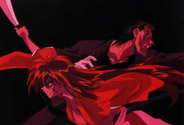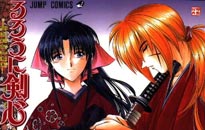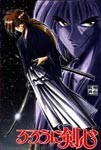

A Hitokiri is a Hitokiri until death, after all.
From: Rurouni Kenshin (Nobuhiro Watsuki)
![]() This guy takes internal moral conflict to new levels of insanity. He is a recovering assassin who chooses to live as a masterless fighter, always ready to help the helpless and befriend the friendless. Kenshin lives in the dojo of an unmarried, orphaned, female martial arts sensei and her insolent young student in a very progressive version of Meiji-era Tokyo (late 19th-century Japan). An array of friends and neighbors stop by often and hang out indefinitely, although occasionally they serve a purpose in the Battle Against Injustice. Domestic life is bliss when you have a man who cooks, cleans, prepares baths, and does the laundry ("nice and white!").
This guy takes internal moral conflict to new levels of insanity. He is a recovering assassin who chooses to live as a masterless fighter, always ready to help the helpless and befriend the friendless. Kenshin lives in the dojo of an unmarried, orphaned, female martial arts sensei and her insolent young student in a very progressive version of Meiji-era Tokyo (late 19th-century Japan). An array of friends and neighbors stop by often and hang out indefinitely, although occasionally they serve a purpose in the Battle Against Injustice. Domestic life is bliss when you have a man who cooks, cleans, prepares baths, and does the laundry ("nice and white!").
![]() Thankfully for the fans, the peace is frequently broken by violent seekers of Kenshin's suppressed alter-ego, Hitokiri Battousai. Some interlopers want the glory of taking down the great warrior-assassin, but others have deeper, more personal reasons for their grudge against the Battousai. Flashbacks depict an interesting tale of the horrors and atrocities committed by Kenshin-as-Battousai during the Bakumatsu no Douran (series of Civil Wars that ended the Tokugawa Shogunate), all in support of the Ishin political group.
Thankfully for the fans, the peace is frequently broken by violent seekers of Kenshin's suppressed alter-ego, Hitokiri Battousai. Some interlopers want the glory of taking down the great warrior-assassin, but others have deeper, more personal reasons for their grudge against the Battousai. Flashbacks depict an interesting tale of the horrors and atrocities committed by Kenshin-as-Battousai during the Bakumatsu no Douran (series of Civil Wars that ended the Tokugawa Shogunate), all in support of the Ishin political group.

![]() The nature of the Ishin-shishi is complex, and their actions raise all sorts of questions about the nobility of revolutionaries both before and after the fighting is over. Kenshin still believes in their stated goal of a future peaceful land, but his wary partnership with the Meiji-era government is benighted by political and military conflicts that tangle the good guy-bad guy line beyond all recognition.
The nature of the Ishin-shishi is complex, and their actions raise all sorts of questions about the nobility of revolutionaries both before and after the fighting is over. Kenshin still believes in their stated goal of a future peaceful land, but his wary partnership with the Meiji-era government is benighted by political and military conflicts that tangle the good guy-bad guy line beyond all recognition.
![]() On a basic psychological level, the Battousai represents Kenshin's most basic instincts and emotional impulses. The ability to clearly identify obstacles to goals and the freedom to remove those obstacles without regard to ethical or practical constraints make the figure of the Hitokiri very seductive and very useful in wartime. But peacetime calls for more sophisticated techniques as the preservation of populace and property becomes important.
On a basic psychological level, the Battousai represents Kenshin's most basic instincts and emotional impulses. The ability to clearly identify obstacles to goals and the freedom to remove those obstacles without regard to ethical or practical constraints make the figure of the Hitokiri very seductive and very useful in wartime. But peacetime calls for more sophisticated techniques as the preservation of populace and property becomes important.
![]() As a rule, the warriors of that bygone era are shown in flashbacks as lethal but lonely: they rely only on their own skills and instincts to see them through the day and there is no time or place for loved ones. Of those who survived the killing, only the ones who receive and accept the love of others are shown as redeemed. The path to redemption is more often laced with tragedy than humor, as far as I can tell. Still, the characters who make the effort are rewarded with Inner Strength, which is an improvement upon the usual "Power-Up" found in a lot of fight-based anime shows.
As a rule, the warriors of that bygone era are shown in flashbacks as lethal but lonely: they rely only on their own skills and instincts to see them through the day and there is no time or place for loved ones. Of those who survived the killing, only the ones who receive and accept the love of others are shown as redeemed. The path to redemption is more often laced with tragedy than humor, as far as I can tell. Still, the characters who make the effort are rewarded with Inner Strength, which is an improvement upon the usual "Power-Up" found in a lot of fight-based anime shows.

![]() For much of the series, Kenshin uses strict personal discipline to resist the temptation to enter Battousai-mode, which in my opinion, only makes the emotional surge that much more powerful. A major part of this discipline is his non-killing oath (not to be confused with pacifism) and his polite, deferential demeanor. Careful watchers/readers can tell when his control is slipping because he adopts a more agressive, confrontational style of speech. ('Sessha' is replaced by 'ore' when he refers to himself in Battousai-mode, and he generally sheds his peppy 'oro'.)
For much of the series, Kenshin uses strict personal discipline to resist the temptation to enter Battousai-mode, which in my opinion, only makes the emotional surge that much more powerful. A major part of this discipline is his non-killing oath (not to be confused with pacifism) and his polite, deferential demeanor. Careful watchers/readers can tell when his control is slipping because he adopts a more agressive, confrontational style of speech. ('Sessha' is replaced by 'ore' when he refers to himself in Battousai-mode, and he generally sheds his peppy 'oro'.)
![]() Perhaps if he listened to his teacher/father figure Hiko Seijurou, he would learn how to accept his own fierce instincts and human limitations instead of constantly ignoring both to the detriment of body and sanity. It would at least be more interesting if Kenshin walked the path of the true warrior, strengthened and supported by lovers and friends, and facing the ills of a society in confusion. There's at least one other character in the series who may be on such a path, Saitoh Hajime.
Perhaps if he listened to his teacher/father figure Hiko Seijurou, he would learn how to accept his own fierce instincts and human limitations instead of constantly ignoring both to the detriment of body and sanity. It would at least be more interesting if Kenshin walked the path of the true warrior, strengthened and supported by lovers and friends, and facing the ills of a society in confusion. There's at least one other character in the series who may be on such a path, Saitoh Hajime.

![]() Saitoh is Kenshin's old nemesis and probably the only man who understands the inner torture of the Battousai. Kenshin as a symbol of all people in hard times could learn a lot from Saitoh: deal with life as it happens, never hurt your friends or underestimate your enemies, and always be true to yourself. Of course since Kenshin's a character in a story, while that advice could be really helpful it would surely make the show rather bland. Happily for everybody, Kenshin doesn't figure out the true path until all the enemies have been vanquished and the dust's settled at the Kamiya dojo.
Saitoh is Kenshin's old nemesis and probably the only man who understands the inner torture of the Battousai. Kenshin as a symbol of all people in hard times could learn a lot from Saitoh: deal with life as it happens, never hurt your friends or underestimate your enemies, and always be true to yourself. Of course since Kenshin's a character in a story, while that advice could be really helpful it would surely make the show rather bland. Happily for everybody, Kenshin doesn't figure out the true path until all the enemies have been vanquished and the dust's settled at the Kamiya dojo.